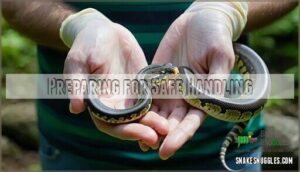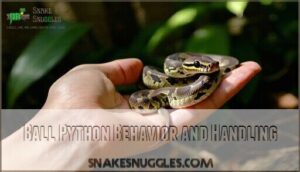This site is supported by our readers. We may earn a commission, at no cost to you, if you purchase through links.

Approach slowly with calm movements—pythons can sense your energy like a mood ring. Support their body weight by letting them flow through your hands rather than gripping tightly.
Keep sessions short, around 10-15 minutes, to minimize stress. Always wash your hands before and after handling to prevent bacterial transfer.
Never grab near the head, as this triggers their defensive instincts. Understanding your python’s body language and behavioral cues reveals the secrets to building lasting trust.
Table Of Contents
- Key Takeaways
- Preparing for Safe Handling
- Choosing The Right Time to Handle
- Safe Handling Techniques
- Managing Stress and Fear
- Safety Precautions
- Handling Ball Pythons of Different Ages
- Handling Ball Pythons in Different Environments
- Long-Term Commitment to Ball Python Handling
- Ball Python Behavior and Handling
- Providing Proper Care and Housing
- Frequently Asked Questions (FAQs)
- What are Python security best practices?
- How do I Secure my Python application?
- How do I improve security in Python?
- How do you handle a ball python?
- How secure is Python?
- How do you stop a ball python from falling off?
- Is it safe to handle a python?
- What is the best way to handle a python?
- Are pythons safe to be around?
- Should you handle a ball python?
- Conclusion
Key Takeaways
- Time your handling sessions carefully – Wait at least 48 hours after feeding and avoid handling during shedding periods when your snake’s skin appears cloudy or its eyes look milky.
- Support your python’s body properly – Use both hands to support at least one-third of the snake’s length, letting it flow through your hands rather than gripping tightly, and never grab near the head or lift by the tail alone.
- Move slowly and stay calm – Approach your python with deliberate, underwater-like movements and maintain a relaxed demeanor since snakes can sense your energy and respond better to patient, predictable interactions.
- Maintain strict hygiene protocols – Wash your hands thoroughly before and after every handling session to prevent bacterial transmission, and keep handling sessions short (10-15 minutes) to minimize stress for both you and your snake.
Preparing for Safe Handling
Before you touch your python, you’ll need to establish proper hygiene protocols and environmental conditions to guarantee both your safety and your snake’s well-being.
Think of preparation as your insurance policy against stress, injury, and potential health complications that can arise from improper handling techniques, ensuring a safe and healthy environment for both you and your snake through proper hygiene.
Importance of Cleanliness
Hand hygiene sets the foundation for safe python handling—wash thoroughly before and after every interaction to prevent bacterial transmission.
Terrarium sanitation demands consistent attention; clean substrates and proper disinfection methods create a healthy environment.
Your substrate choice directly impacts parasite prevention, while water cleanliness maintains ideal conditions.
Using alcohol-based sanitizers can further reduce risks.
Remember, cleanliness isn’t optional—it’s your python’s lifeline and your safety guarantee.
Pre-Handling Checklist
You’re about to handle your ball python, so let’s make sure everything’s perfect first.
This pre-handling checklist guarantees both your safety and your snake’s comfort during the interaction.
- Handler Preparation: Wash hands thoroughly and gather any necessary Safety Gear
- Health Assessment: Check your python’s temperament and overall condition
- Environment Check: Verify ideal terrarium temperature and humidity levels
- Handling Tools: Have snake hooks or other equipment ready if needed
Maintaining a Clean Terrarium
Your python’s enclosure needs consistent cleanliness to prevent parasites and disease.
Choose substrate like coconut fiber or aspen for easy maintenance and proper hygiene.
Use safe disinfection methods weekly, ensuring adequate ventilation prevents mold growth.
Clean water dishes regularly since stagnant water breeds bacteria.
This enclosure upkeep directly impacts your snake’s health and makes handling safer for both of you.
Choosing The Right Time to Handle
Timing your python handling sessions correctly prevents stress and health complications that can arise from poor scheduling decisions.
You’ll need to examine your snake’s feeding schedule, shedding cycle, and natural behavior patterns to guarantee each interaction promotes trust while maintaining your python’s physical well-being.
This approach ensures that trust is built between you and your python, which is essential for a healthy and safe relationship.
Handling Frequency
Finding the right handling frequency for your python isn’t rocket science, but it requires attention to detail.
Most adult pythons thrive with handling 1-2 times weekly, while younger snakes benefit from more frequent interaction.
Consider these key factors when determining your python’s handling schedule:
- Age considerations: Juveniles need weekly sessions for socialization
- Health impacts: Skip handling if your snake shows illness signs
- Temperament effects: Defensive pythons require patience and less frequent contact
- Handling duration: Keep sessions under 30 minutes maximum
- Seasonal variations: Reduce frequency during breeding season or winter cooling
Avoiding Handling During Shedding
Beyond proper handling frequency, timing becomes even more critical during your python’s shedding cycle. When snakes enter this natural process, their skin sensitivity increases dramatically, making them feel vulnerable and irritable.
| Shedding Stage | Python’s State | Your Action |
|---|---|---|
| Pre-shed (eyes cloudy) | Stressed, defensive | Avoid handling completely |
| Active shedding | Highly irritable | Hands off approach |
| Post-shed handling | Relaxed, renewed | Resume gentle handling |
Irritability factors spike during shedding vulnerability, so respect their space. This safety measure reduces stress and prevents defensive behaviors that could lead to bites.
Avoiding Handling After Feeding
Just like shedding, your python’s feeding schedule dictates safe handling windows.
Your snake’s stomach works overtime after meals, and premature python handling disrupts this critical digestion time.
Wait 48-72 hours post-feeding to avoid regurgitation risk and guarantee python comfort.
Here’s why patience pays off:
- Prevents messy accidents that stress both you and your snake
- Protects your python’s health from digestive complications
- Maintains trust through consistent, respectful care
Safe Handling Techniques
Proper handling technique forms the foundation of safe python interaction, requiring calm movements and confident body support to prevent stress for both you and your snake.
You’ll need to master specific grip positions, understand approach methods, and maintain steady control while allowing your python to move naturally through your hands.
Approaching The Snake Calmly
Your success with python handling starts with mastering the calm approach. Moving like you’re underwater—slow movements are essential for building confidence with your snake. Python behavior suggests they respond best to a calm demeanor rather than rushed interactions.
Start with scent introduction by allowing your python to smell your hand before making contact. This simple step prevents startling and establishes trust. Avoid startling your snake by staying within its line of sight and approaching from the side rather than directly above.
| Approach Method | Snake Response | Handler Benefit |
|---|---|---|
| Slow, deliberate movements | Relaxed posture | Builds trust over time |
| Gentle voice tones | Reduced defensive behavior | Creates calm environment |
| Scent familiarization | Recognition and acceptance | Establishes positive association |
| Side approach technique | Less defensive positioning | Avoids triggering escape response |
| Patient waiting periods | Natural curiosity emerges | Allows snake to initiate contact |
These python handling tips form the foundation of safe snake handling. Remember, your snake handling techniques should mirror the snake’s natural pace—unhurried and confident.
Supporting The Snake’s Body
Proper Support transforms python handling from intimidating to manageable. Think of cradling a sleepy cat—you’ll need both hands for secure Grip Techniques. Place one hand under the snake’s midsection and another supporting its lower body, ensuring even Weight Distribution across your arms.
This Body Support Technique prevents Muscle Strain while Avoiding Injury to both you and your python:
- Never lift by the tail alone—this causes spinal damage
- Support at least one-third of the snake’s length at all times
- Allow natural movement while maintaining gentle control
Using appropriate handling equipment can further improve safety. These python handling tips create stress-free experiences.
Handling The Snake’s Head
Now that you’ve mastered body support, let’s talk head handling.
Never grab or squeeze the snake’s head—this triggers defensive responses. Instead, maintain a secure grip behind the jawbone area only when absolutely necessary for avoiding bites.
Most handling sessions don’t require head control at all. Focus on jawbone control techniques from your snake handling course for emergency situations, ensuring safe release afterward.
Avoiding Sudden Movements
Calm approach and slow movements prevent your python from startling during handling sessions.
Gradual introduction of your hands builds confidence, while steady hands guarantee predictable movements that reduce snake handling risks.
Jerky motions trigger defensive responses, creating handling risks that experienced keepers avoid.
Python handling precautions include moving deliberately—think of approaching a sleeping cat rather than surprising it with sudden gestures.
Managing Stress and Fear
Even experienced handlers can feel nervous around pythons, but recognizing your snake’s stress signals, like coiling tightly or rapid breathing, helps you respond appropriately and maintain everyone’s comfort.
You’ll build confidence through consistent, gentle interactions that allow your python to become familiar with your scent and movements while learning to read its body language for safer handling sessions, which ultimately leads to safer handling.
Recognizing Stress Signs in Ball Pythons
Your ball python’s stress indicators tell a story through their body language.
Watch for coiling behavior where they tighten into defensive balls, sharp hissing sounds, and tense defensive postures with raised heads.
Breathing changes like rapid or shallow patterns signal distress, while regurgitation signs after handling show severe stress.
These snake stress indicators help you recognize when your ball python needs space, preventing escalated snake behavior signs before they worsen.
Minimizing Stress During Handling
Once you’ve spotted stress signals in your ball python, implementing techniques to minimize anxiety becomes your next priority.
Successful python handling relies on creating a Safe Environment where your snake feels secure throughout each interaction.
Your Calm Approach sets the foundation for stress-free sessions.
- Gentle Touch – Support their body weight without gripping tightly
- Move deliberately and avoid jerky motions that startle
- Observe Body language continuously for tension signs
- Use Positive Reinforcement by ending sessions on peaceful notes
Understanding snake behavior helps you read their comfort levels during handling.
Building Trust With Your Ball Python
Building trust with your ball python requires consistent interaction and patience building.
Start with brief, gentle sessions to establish positive reinforcement patterns.
Your snake will gradually recognize your scent and touch as non-threatening through gradual acclimation.
Reading signals becomes easier as familiarity grows—relaxed posture means you’re on track.
Don’t rush; some pythons need weeks to feel comfortable.
Safety improves when trust develops, reducing defensive behavior and stress responses.
Remember, each handling session builds confidence, creating a foundation for lifelong cooperation between you and your snake.
If you notice heavy breathing, muscle tremors, or skin discoloration, which are common signs of a snake is stressed.
Don’t force interaction if your snake is stressed, as this can undermine the trust-building process and lead to increased defensive behavior.
Safety Precautions
When you’re handling your python, proper safety measures protect both you and your snake from unnecessary injuries and health risks.
Understanding how to prevent bites, respond to accidents, and maintain hygiene will guarantee that every interaction remains positive and stress-free for both of you.
Preventing Bites and Injuries
Most python bites happen when handlers miss early warning signs or use improper restraint techniques. Watch for defensive posturing, rapid breathing, or S-shaped coiling before handling. Trust builds through consistent, gentle interactions.
- Use snake handling tools like hooks for initial contact
- Maintain safe restraint by supporting the body properly
- Recognize aggression through hissing or striking motions
- Apply handling precautions by moving slowly and deliberately
Managing Bites and Injuries
Despite careful snake handling, bites occasionally occur during routine care.
Assess bite severity immediately—most ball python bites cause minor punctures.
Clean wounds thoroughly with soap and water for proper wound care.
Apply antibiotic ointment and monitor for infection signs like swelling or redness.
Seek medical attention if healing stalls.
Effective first aid and preventative measures guarantee safe injury handling.
Preventing Salmonella Infection
When handling pythons, salmonella prevention becomes your top priority since these reptiles naturally carry bacteria that can make you seriously ill.
Proper hygiene practices protect both you and your family from infection.
- Handwashing Importance: Scrub hands thoroughly with soap for 20 seconds before and after handling
- Disinfection Methods: Clean enclosures weekly using reptile-safe disinfectants
- Tool Separation: Use separate equipment for feeding and cleaning tasks
- Veterinary Checkups: Schedule regular health examinations for early detection
Preventing Salmonella Infection – Python Handling Safety
When handling pythons, salmonella prevention becomes your top priority since these reptiles naturally carry bacteria that can make you seriously ill.
Proper hygiene practices protect both you and your family from infection.
- Handwashing Importance: Scrub hands thoroughly with soap for 20 seconds before and after handling
- Disinfection Methods: Clean enclosures weekly using reptile-safe disinfectants
- Tool Separation: Use separate equipment for feeding and cleaning tasks
- Veterinary Checkups: Schedule regular health examinations for early detection
Handling Ball Pythons of Different Ages
Ball pythons at different life stages require distinct handling approaches, as younger snakes are more fragile and defensive while adults are generally calmer but require more physical support.
You’ll need to adjust your technique based on whether you’re working with a delicate hatchling that fits in your palm or a robust adult that can stretch across your arms, which involves understanding the unique needs of each life stage.
Handling Hatchlings and Juveniles
Young ball python hatchlings and juveniles require Fragile Handling with a Gentle Approach.
Their Feeding Considerations include waiting 48 hours post-meal before handling. Growth Monitoring helps track development, while Enrichment Needs support healthy behavior.
These delicate snakes need safe handling techniques – support their bodies completely and limit sessions to prevent stress.
| Age Group | Handling Frequency | Special Considerations |
|---|---|---|
| Hatchlings | Once weekly | Extra gentle touch |
| Juveniles | 2-3 times weekly | Monitor growth spurts |
| Both | Short sessions | Watch stress signals |
Handling Adult Ball Pythons
Most adult ball pythons display a calm temperament, making ball python handling more predictable than with younger snakes.
Most adult ball pythons display a calm temperament, making ball python handling more predictable than with younger snakes.
Adult ball pythons are nature’s gentle giants—calm, predictable, and surprisingly cooperative during handling sessions.
Support their entire body during each session, keeping handling frequency to 1-2 times weekly for ideal safety.
Brief 15-20 minute encounters prevent stress while building trust through consistent interaction.
Watch their body language—relaxed postures indicate comfort.
Bite prevention starts with washing hands beforehand, and post-handling care includes thorough handwashing to avoid salmonella transmission.
Handling Ball Pythons During Shedding
Ball pythons become vulnerable during shedding, making handling risky for both snake and owner.
You’ll notice cloudy eyes and dull skin signaling the process has begun.
Resist the urge to handle your ball python during this sensitive time.
Smart alternatives protect your snake from unnecessary stress:
- Create a humid hide using damp moss or towels
- Monitor shedding environment for proper humidity levels
- Avoid shedding assistance unless absolutely necessary
- Wait for post-shed handling once skin appears bright again
Handling Ball Pythons in Different Environments
Whether you’re handling your ball python in its familiar terrarium or during transport to a new location, different environments require specific adjustments to your technique and preparation.
You’ll need to account for factors like temperature changes, unfamiliar surroundings, and your snake’s heightened stress response when moving between spaces, since even well-socialized pythons can become more defensive outside their established territory due to unfamiliar surroundings and a heightened stress response.
Handling Ball Pythons in Captivity
When you’re handling your ball python in its familiar territory, recognizing stress signals becomes second nature.
Gauge your snake’s mood by watching for relaxed coiling and steady breathing patterns.
Keep handling frequency moderate—twice weekly works well for building trust while preventing bites.
Enclosure safety matters; make certain secure but accessible housing.
Supporting your python’s body properly creates positive associations with human contact.
Handling Ball Pythons in Transit
Your ball python’s journey requires careful planning to reduce stress and safe transport. Temperature regulation becomes critical during transit, so use a 12v DC heat mat or hand warmers matched to weather conditions.
Follow these secure transport essentials:
- Choose breathable bags over rigid containers for better airflow
- Maintain consistent temperatures with appropriate heating elements
- Secure the travel enclosure in a stable vehicle position
- Prepare a quiet, clean habitat for post-travel care
Choosing the correct ball python carrier is vital for a safe trip.
After transit, allow 1-2 weeks for acclimation in their safe environment before handling resumes.
Long-Term Commitment to Ball Python Handling
Owning a ball python isn’t just about occasional handling sessions—it’s about building a lasting relationship that requires consistent, patient interaction over the snake’s 20-30 year lifespan.
You’ll need to maintain regular handling schedules, adapt your techniques as your python ages, and continuously monitor their stress levels.
This guarantees both your safety and their well-being throughout this long-term commitment.
Building a Relationship With Your Ball Python
The foundation of any strong relationship starts with understanding, and building trust with your ball python follows this same principle.
Consistent handling creates familiarity, while positive reinforcement through gentle interactions helps your snake recognize you as safe. Trust-building exercises like allowing your python to explore your hands demonstrate respect for their temperament.
| Trust-Building Stage | Timeline | Key Behaviors |
|---|---|---|
| Initial Acclimation | 1-2 weeks | Snake remains calm when cage opens |
| Recognition Phase | 3-4 weeks | Approaches handler without defensiveness |
| Comfort Development | 5-8 weeks | Relaxed body language during handling |
| Trust Establishment | 2-3 months | Seeks out interaction, confident behavior |
| Strong Bond | 4+ months | Complete comfort, predictable temperament |
Handling consistency in a secure environment helps your snake develop recognizing comfort cues, making each interaction safer and more enjoyable for both of you.
Managing Stress and Fear Long-Term
Once you’ve established that initial bond, maintaining your python’s comfort becomes a marathon, not a sprint.
Consistent interaction paired with environmental enrichment creates lasting calm. Your snake’s behavior will reflect your commitment to reducing anxiety through patient, repeated positive reinforcement experiences that build confidence over time.
- Schedule regular handling sessions to maintain familiarity and trust
- Create enriching environments with hiding spots and climbing opportunities
- Use positive reinforcement by associating your presence with calm experiences
- Monitor stress signals like defensive posturing or rapid breathing patterns
- Maintain consistent routines for feeding, cleaning, and safe handling practices
Ball Python Behavior and Handling
Understanding your ball python’s body language serves as your primary communication tool, helping you recognize when it’s comfortable, stressed, or preparing to shed.
You’ll need to observe breathing patterns and track feeding schedules carefully, since these behavioral cues determine the safest times for handling and help you build a trusting relationship with your snake, which is crucial for its well-being and your safety, allowing for a better understanding of its body language.
Understanding Body Language
Reading your python’s body language reveals its comfort level during handling.
A relaxed snake displays loose coiling and smooth movements, while stress appears through tight coiling, rapid tongue flicking, or defensive posturing.
Interpreting these cues helps you recognize when your python feels calm versus anxious.
Watch for handling responses like exploration versus withdrawal—these behaviors guide safe, stress-free interactions with your snake.
Paying Attention to Breathing Patterns
Your python’s breathing patterns serve as a vital health indicator during handling.
Normal respiration appears steady and quiet, while respiratory distress shows through rapid breathing rate or labored movements.
Listen for abnormal sounds like wheezing or clicking, which signal potential illness.
Shedding impact can temporarily affect breathing, making monitoring essential.
These body language cues help safeguard safety during every interaction.
Noting Feeding Schedules
Your python’s feeding schedule serves as the cornerstone for safe handling practices.
Track feeding dates painstakingly to prevent regurgitation and guarantee safe safety.
Adult pythons typically eat every 10-14 days, while juveniles require weekly meals.
Record prey type and food size to monitor growth patterns and behavior changes.
Wait 48-72 hours after feeding before handling to allow proper digestion.
These appropriate intervals provide significant feeding schedule benefits, including reduced stress and improved regurgitation prevention during interactions.
Providing Proper Care and Housing
Your python’s environment serves as the foundation for safe handling, since a well-housed snake remains calm and predictable during interactions.
You’ll find that maintaining proper enclosure conditions, temperature gradients, and feeding schedules directly impacts your snake’s temperament and reduces handling stress.
Enclosure Size and Type
Your ball python’s enclosure size becomes their entire universe, so getting it right matters tremendously. Start with a 20-gallon tank for juveniles, then upgrade to 40 gallons for adults.
Terrarium dimensions should prioritize floor space over height since ball pythons aren’t climbers. Glass terrariums with secure enclosure features work well, but PVC enclosures offer superior insulation.
Choose substrate choices like coconut fiber or aspen shavings—avoid cedar and pine as they’re toxic. Proper ventilation needs prevent mold while maintaining humidity.
Consider these emotional benefits of proper python enclosure setup:
- Your python feels secure in appropriately-sized spaces
- Enrichment items like hides reduce stress and anxiety
- Adequate space prevents territorial aggression
- Security features protect your beloved companion from escapes
Temperature and Humidity Control
Creating the perfect climate for your python isn’t rocket science, but it does require attention to detail. Heating gradients are essential—maintain your enclosure with a basking spot at 90-95°F and a cool side around 78-80°F.
Your python needs this temperature range to regulate its body properly, which directly affects how comfortable it’ll be during handling.
For humidity levels, aim for 50-60% daily, bumping it up to 80% during shedding periods. Thermostat calibration prevents dangerous overheating, while reliable monitoring devices like digital hygrometers keep you informed.
Don’t forget seasonal adjustments—your snake’s needs may shift slightly throughout the year. Proper ventilation prevents mold growth, ensuring your python stays healthy and stress-free when you interact with it.
Diet and Hydration
After establishing proper temperature and humidity, your python’s diet and hydration become your next priority.
A well-fed snake is easier to handle and less likely to mistake your hand for dinner.
Here’s your feeding roadmap:
- Prey Size: Choose frozen-thawed prey that’s 1-1.5 times your python’s thickest body section
- Feeding Schedule: Adults eat every 10-14 days; juveniles need weekly meals
- Water Quality: Provide fresh, clean water in a soaking-sized dish daily
Frequently Asked Questions (FAQs)
What are Python security best practices?
Like a digital fortress protecting valuable treasures, you’ll want strong passwords, regular updates, input validation, secure libraries, encrypted connections, limited permissions, code reviews, and monitoring tools to shield your Python applications from cyber threats.
How do I Secure my Python application?
You’ll want to validate all user inputs, use environment variables for secrets, enable HTTPS everywhere, implement proper authentication and authorization.
Keep dependencies updated, sanitize database queries, and regularly audit your code for vulnerabilities.
How do I improve security in Python?
Security vulnerabilities can absolutely devastate your Python applications if you’re not careful.
You’ll want to validate all inputs, use parameterized queries, keep dependencies updated, implement proper authentication, and never hardcode sensitive credentials in your source code, to prevent issues like these from arising due to security vulnerabilities.
How do you handle a ball python?
Support your ball python’s body with both hands, moving slowly and confidently.
Wait 48 hours after feeding before handling.
Keep sessions under 30 minutes, watching for stress signs like defensive coiling or hissing.
How secure is Python?
Unlike physical snake handling, Python programming language offers robust security features, but you’ll need to implement proper practices.
It’s secure when you validate inputs, use updated libraries, and follow coding standards diligently.
How do you stop a ball python from falling off?
Support your ball python’s body with both hands, keeping one near the head and another mid-body.
Move slowly, maintain a secure but gentle grip, and let the snake wrap around your arm naturally for stability.
Let the snake have enough space to move around comfortably.
Is it safe to handle a python?
Handling pythons is like walking a tightrope—it’s manageable with proper technique and preparation.
You can safely handle captive pythons by washing hands first, supporting their body weight, moving slowly, and avoiding feeding times.
What is the best way to handle a python?
Approach slowly, support the snake’s body with both hands—one behind the head, one mid-body.
Move gently, let it explore while maintaining control.
Never grab the tail; it’ll cause serious injury.
Are pythons safe to be around?
Pythons aren’t inherently dangerous to humans, but you’ll want respect and caution around them.
They’re non-venomous constrictors that rarely attack unless threatened, hungry, or protecting territory.
Proper knowledge guarantees safe coexistence.
Should you handle a ball python?
You should handle your ball python regularly, about 1-2 times weekly.
This builds trust, keeps them docile, and helps monitor their health.
Wait 48 hours after feeding and avoid handling during shedding periods.
Conclusion
Studies show that properly handled ball pythons live 15-20% longer than those subjected to stressful handling practices.
Mastering how to safely handle a python requires patience, consistency, and respect for your snake’s natural behaviors.
You’ll build stronger bonds through gentle, predictable interactions while maintaining proper hygiene protocols.
Remember that each python develops its unique personality over time.
With these expert techniques, you’re equipped to provide exceptional care that promotes your snake’s physical health and psychological well-being for years ahead.
- https://www.wikihow.com/Hold-a-Snake
- https://www.quora.com/What-are-the-potential-dangers-of-holding-a-python-behind-its-neck-when-handling-them-as-pets-Are-there-any-alternative-methods-for-handling-them-safely
- https://reptilesupershow.com/snake-handling-safety-tips-for-secure-encounters/
- https://community.morphmarket.com/t/to-handle-or-not-to-handle-that-is-the-question/42388
- https://www.youtube.com/watch?v=4kJQzHtxPc8





















